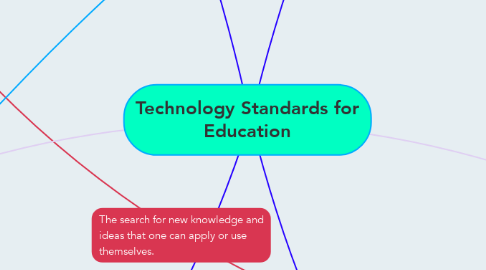Technology Standards for Education
by katie mack

1. ISTE Standards for Teachers
1.1. Facilitate and Inspire Student Learning and Creativity: Teachers use their knowledge of subject matter, teaching and learning, and technology to facilitate experiences that advance student learning, creativity and innovation in both face-to-face and virtual environments.
1.2. Design and Develop Digital Age Learning Experiences and Assessments: Teachers design, develop and evaluate authentic learning experiences and assessments incorporating contemporary tools and resources to maximize content learning in context and to develop the knowledge, skills and attitudes identified in the ISTE Standard.
1.3. Model Digital Age Work and Learning: Teachers exhibit knowledge, skills and work processes representative of an innovative professional in a global and digital society.
1.4. Promote and Model Digital Citizenship and Responsibility: Teachers understand local and global societal issues and responsibilities in an evolving digital culture and exhibit legal and ethical behavior in their professional practices.
1.5. Engage in Professional Growth and Leadership: Teachers continuously improve their professional practice, model lifelong learning and exhibit leadership in their school and professional communities by promoting and demonstrating the effective use of digital tools and resources.
2. ISTE Standards for Students
2.1. Empowered Learner: Students leverage technology to take an active role in choosing, achieving and demonstrating competency in their learning goals, informed by the learning sciences.
2.2. Digital Citizen: Students recognize the rights, responsibilities and opportunities of living, learning and working in an interconnected digital world, and they act and model in ways that are safe, legal and ethical.
2.3. Knowledge Constructor: Students critically curate a variety of resources using digital tools to construct knowledge, produce creative artifacts and make meaningful learning experiences for themselves and others.
2.4. Innovative Designer: Students use a variety of technologies within a design process to identify and solve problems by creating new, useful or imaginative solutions.
2.5. Creative Communicator: Students communicate clearly and express themselves creatively for a variety of purposes using the platforms, tools, styles, formats and digital media appropriate to their goals.
3. Learning and Technology Policy Framework
3.1. Student-Centered Learning: Technology is used to support student centered, personalized, authentic learning for all students.
3.2. Research and Innovation: Teachers, administrators and other education professionals read, review, participate in, share and apply research and evidence-based practices to sustain and advance innovation in education.
3.3. Professional Learning: Teachers, administrators and other education professionals develop, maintain and apply the knowledge, skills and attributes that enable them to use technology effectively, efficiently and innovatively in support of learning and teaching.
3.4. Leadership: Education leaders establish policy and governance structures, cultivate innovation and build capacity within the system to leverage technology in support of student-centred learning and system efficiencies.
3.5. Access, Infrastructure and Digital Learning Environments: All students, teachers, administrators and other education professionals have access to appropriate devices, reliable infrastructure, high-speed networks and digital learning environments.
4. ICT Program of Studies
4.1. Communicating, Inquiring, Decision Making and Problem Solving: The ability to use a variety of processes to critically assess information, manage inquiry, solve problems, do research and communicate with a variety of audiences.
4.2. Foundational Operations, Knowledge and Concepts: Understanding the nature and affect of technology, the moral and ethical use of technology, mass media in a digitized context, ergonomic and safety issues, and basic computer, telecommunication and multimedia technology operations
4.3. Processes for Productivity: Knowledge and skills required to use a variety of basic productivity tools and techniques.
4.4. Gathering and Identifying Information: To gain a wider span of knowledge than is currently held.
4.5. Analyzing and Evaluating: To better understand information and its meaning.


